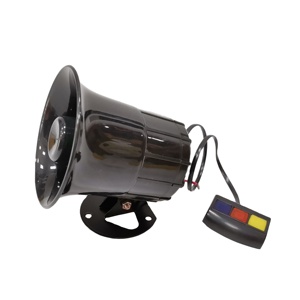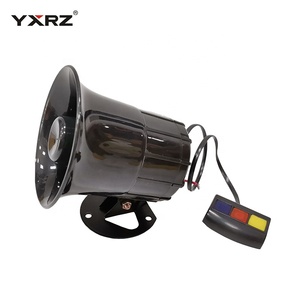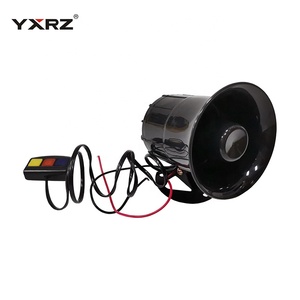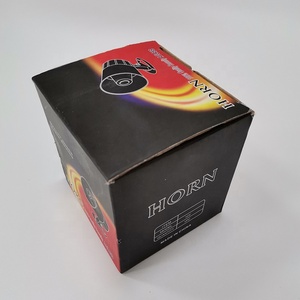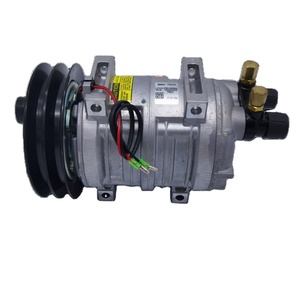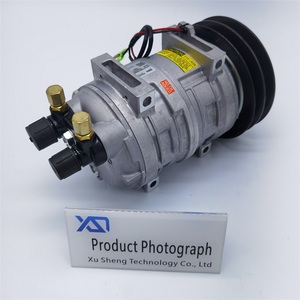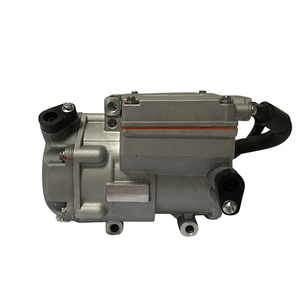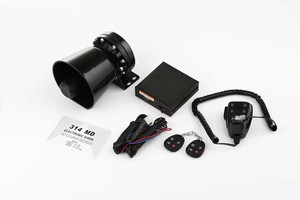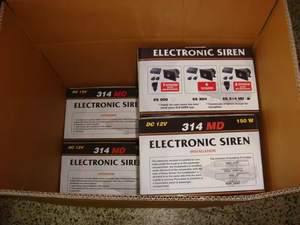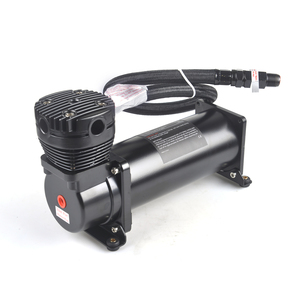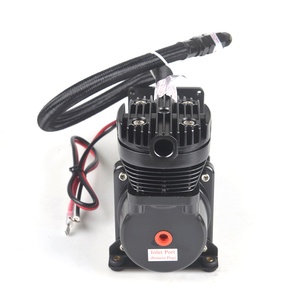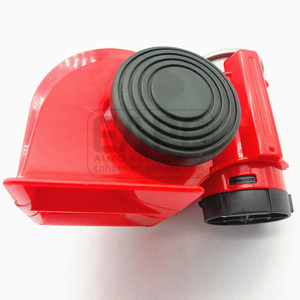Types of Air Horn Compressor 12V
A 12v air horn compressor is a small electric pump that runs on 12V power, typically from a vehicle's battery. It uses an electric motor to drive a pump that compresses and moves air to produce sound through the horn. These systems are widely used on vehicles from small cars to large trucks and trains for signaling or alerting others. Let's explore the different types available:
Single vs. Dual vs. Triple Horns
- Single Horn: Produces a basic sound level, suitable for most cars and smaller vehicles
- Dual Horn: Features two horns that generate a louder, more attention-grabbing sound, ideal for trucks and larger vehicles
- Triple Horn: Creates the loudest sound with three horns, commonly used on large trucks, trains, and commercial vehicles where sound needs to carry over long distances
Best for: Triple horns for maximum volume, single horns for standard applications
High-Pressure vs. Low-Pressure
- High-Pressure: Builds significant pressure inside the horn, producing a loud, piercing sound that's ideal for construction sites, busy roads, or emergency situations
- Low-Pressure: Generates less intense sound suitable for applications where excessive noise isn't necessary or appropriate
Best for: High-pressure for maximum alerting capability, low-pressure for regular use
Electric vs. Air-Operated
- Electric: Relies on electricity to power the motor, representing the most common type found in passenger vehicles
- Air-Operated: Uses compressed air from the vehicle's air brake system, offering more power but requiring a pressurized air system
Best for: Electric for standard applications, air-operated for heavy-duty commercial vehicles
Expert Tip: When selecting a horn type, consider both your vehicle's power system and the environment where you'll be using the horn. For residential areas, a lower-pressure system may be more appropriate, while highway driving might benefit from a louder dual or triple horn setup.
| Horn Type | Sound Level | Best Application | Installation Complexity |
|---|---|---|---|
| Single Horn | 100-110 dB | Standard cars, small vehicles | Low |
| Dual Horn | 115-125 dB | Trucks, SUVs, medium vehicles | Medium |
| Triple Horn | 130-150 dB | Commercial trucks, trains | High |
| Air-Operated | 140-150 dB | Commercial vehicles with air brakes | Very High |
Specifications and Maintenance of Air Horn Compressor 12V
Understanding the technical specifications of 12V air horn compressors is crucial for selecting the right system for your vehicle. These specifications determine performance, sound quality, and overall reliability.
Voltage
Operates on a standard 12V DC power source, typically drawing from a vehicle's battery. This low-voltage system is safe for mobile use and widely compatible with most vehicles.
Air Output
Measured in liters per minute (LPM) or cubic feet per minute (CFM), this specification indicates air delivery capacity. Higher output (2-3 CFM) produces louder, more sustained horn sounds.
Pressure Rating
Typically ranges from 100-150 PSI (pounds per square inch). Higher pressure compressors create more piercing sounds and can operate multiple horns simultaneously.
Noise Level
Measured in decibels (dB), ranging from 100 dB for single horns to 150 dB for triple systems. For reference, 120 dB is comparable to a rock concert, while 150 dB can cause immediate hearing damage.
Materials
High-quality compressors use stainless steel, ABS plastic, or aluminum components. Material choice affects durability, corrosion resistance, and performance in extreme weather.
Size & Weight
Compact models weigh 1-3 pounds with dimensions around 5"×3"×3", while larger systems can weigh up to 10 pounds with proportionally larger dimensions.
Duty Cycle
Indicates runtime before cooling is needed, typically expressed as a percentage (e.g., 33% means 20 minutes of operation followed by 40 minutes of rest).
Tank Size
If included, measured in liters or gallons. Larger tanks (0.5-2 gallons) store more compressed air for longer or multiple horn blasts without compressor restart.
Power Consumption
Measured in amps (A), typically ranging from 10-30A. Lower consumption places less strain on the vehicle's electrical system but may deliver less power.
Essential Maintenance Practices
Regular maintenance ensures optimal performance, safety, and longevity of your 12V air horn compressor system. Follow these recommended practices:
| Maintenance Task | Frequency | Importance | Notes |
|---|---|---|---|
| Air Filter Inspection | Monthly | High | Clean or replace dirty filters; essential for optimal airflow |
| Hose/Connection Check | Quarterly | Critical | Look for cracks, leaks, or damage; replace damaged components immediately |
| Connection Tightening | Monthly | Medium | Prevent air leaks that reduce performance and increase compressor strain |
| Component Lubrication | Semi-annually | Medium | Use manufacturer-recommended lubricants for moving parts |
| Surface Cleaning | Monthly | Low | Remove dust and debris to prevent overheating and component damage |
| Electrical Connection Check | Quarterly | High | Inspect for corrosion, loose wires, and secure battery connections |
| Full System Test | Quarterly | Medium | Verify proper function and sound output |
Important Safety Note: When testing air horns, always use appropriate hearing protection. Air horns can produce sounds exceeding 120 dB, which can cause permanent hearing damage with prolonged exposure. Never test horns in enclosed spaces or direct them toward people or animals.
How to Choose an Air Horn Compressor 12V
Selecting the right 12V air horn compressor requires consideration of several crucial factors to ensure compatibility with your vehicle and your specific needs. Here's a comprehensive guide to making the best choice:
Compressor Capacity
The most critical factor when selecting an air horn system. The compressor's capacity must match or exceed the horns' air requirements.
- Single Horn: 1-1.5 CFM minimum capacity
- Dual Horn: 1.5-2.5 CFM minimum capacity
- Triple Horn: 2.5-3.5 CFM minimum capacity
Expert advice: Choose a compressor with at least 20% more capacity than the minimum required to prevent premature wear
Noise Level Requirements
Consider where and how you'll use the horn to determine appropriate sound levels:
- Highway Use: 115-130 dB for sufficient audibility
- Urban Use: 100-115 dB balances audibility with noise regulations
- Commercial/Industrial: 130-150 dB for maximum alerting capability
Legal note: Many jurisdictions have noise ordinances limiting horn volume in residential areas
Vehicle Compatibility
Ensure your vehicle can support the system's power and space requirements:
- Power Supply: Verify your electrical system can handle the amperage draw (10-30A depending on model)
- Available Space: Measure mounting locations before purchase
- Weight Capacity: Particularly important for motorcycles and smaller vehicles
Quality & Durability
Look for these indicators of a high-quality system:
- Materials: Stainless steel or marine-grade aluminum for maximum corrosion resistance
- Sealed Components: Weather-resistant electronics and connections
- Warranty: Longer warranties typically indicate manufacturer confidence in product quality
- Reviews: Check user experiences for reliability reports
Professional Recommendation: For most passenger vehicles, a medium-duty dual horn system strikes the optimal balance between sound output, power requirements, and installation complexity. Reserve triple-horn systems for larger vehicles or specialized applications where maximum volume is essential.
How to DIY and Replace Air Horn Compressor 12V
Installing or replacing a 12V air horn compressor is a straightforward project that most vehicle owners can complete with basic tools. Follow this comprehensive guide for a successful installation:
Required Tools & Materials
- 12V air horn kit (compressor, horns, and mounting hardware)
- Fuse holder with appropriate 10-15A fuse
- 16-gauge automotive wire
- Wire connectors and crimping tool
- Relay (typically included in horn kits)
- Momentary or toggle switch (if not using existing horn button)
- Screwdrivers, wrenches, and socket set
- Drill with appropriate bits (if mounting requires new holes)
- Wire cutters/strippers
- Electrical tape or heat shrink tubing
- Air tubing and compression fittings (included in kit)
- O-ring lubricant or silicone grease
- Zip ties for wire management
Installation Procedure
Choose appropriate locations for all components. The compressor should be mounted on a solid surface like the inner fender well or firewall, away from direct heat sources and water exposure. Horns should be positioned facing downward to prevent water accumulation, with clear forward projection for maximum sound effectiveness.
Using the provided mounting brackets and hardware, secure the compressor firmly to your chosen location. Ensure it's level and all mounting points are tight to prevent vibration during operation. If drilling new holes, verify nothing critical is behind your drilling location.
Mount the horn(s) in your preferred location using the provided hardware. Ensure they're angled appropriately for sound projection and protected from direct water exposure. For multiple horns, position them with adequate spacing for optimal sound dispersion.
Cut the air tubing to appropriate lengths, allowing some slack for movement. Connect tubing from the compressor output to the horn inputs using the compression fittings. Apply O-ring lubricant to ensure airtight connections. Secure tubing along its path with zip ties to prevent rubbing against moving parts.
Connect the relay according to the wiring diagram provided with your kit:
- Connect one terminal of the relay to a chassis ground point
- Connect another terminal to the positive battery terminal through the fuse holder
- Connect the switch input terminal to your horn button or standalone switch
- Connect the output terminal to the compressor's positive wire
- Connect the compressor's negative wire to chassis ground
If using a separate switch rather than the vehicle's existing horn button, mount it in an accessible location within the cabin. Drill an appropriate-sized hole, run wiring through the firewall using an existing grommet or by creating a new sealed passage, and connect to the relay as per the diagram.
Check all electrical connections for tightness and insulation. Use electrical tape or heat shrink tubing to protect connections from moisture and short circuits. Ensure all air line connections are secure and leak-free.
With the engine running (to maintain battery voltage), activate the horn system. The compressor should run immediately, and the horns should produce a loud, clear sound. If the compressor runs but no sound occurs, check for air leaks. If nothing happens, verify your electrical connections.
After successful testing, make any necessary adjustments to horn positioning, secure any loose wiring or tubing with additional zip ties, and ensure all mounting hardware is fully tightened.
Safety Warning: Always disconnect the negative battery terminal before beginning any electrical work on your vehicle. This prevents accidental shorts and potential electrical system damage. Reconnect only after all connections are complete and insulated.
Professional Insight: For the most reliable installation, use a dedicated power source with appropriate fusing rather than tapping into existing circuits. This prevents overloading vehicle systems and ensures maximum performance from your air horn system. Consider including a pressure switch if your system has an air tank to maintain optimal pressure levels automatically.
Frequently Asked Questions
The lifespan of a 12-volt air horn compressor varies based on several factors, including quality of components, frequency of use, and maintenance practices. With proper care and moderate use, expect:
- Budget models: 2-4 years of reliable service
- Mid-range systems: 4-7 years with regular maintenance
- Premium systems: 7-10+ years with proper care
Regular maintenance such as keeping connections clean, checking for air leaks, and ensuring proper electrical supply significantly extends compressor life. Systems used frequently or in harsh environments (extreme temperatures, high humidity, salt exposure) typically have shorter lifespans unless specifically designed for these conditions.
Yes, many 12-volt air compressors can inflate car tires, but there are important considerations:
- Capacity: Horn compressors typically produce 100-150 PSI, sufficient for most passenger vehicle tires (30-40 PSI)
- Time Factor: Horn compressors have smaller motors and lower CFM ratings than dedicated tire inflators, meaning they'll take significantly longer to fill a tire
- Duty Cycle: Most horn compressors aren't designed for the extended runtime needed to fill multiple tires from flat, and may overheat
- Adaptability: You'll need appropriate fittings to connect to tire valve stems, often not included with horn kits
For occasional emergency use, a horn compressor can inflate tires, but for regular tire maintenance, a dedicated 12V tire inflator is more efficient and practical.
12-volt air horn systems produce sound levels ranging from 100 to 150 decibels (dB), depending on the type and configuration:
| Horn Configuration | Typical Sound Level | Comparison | Safety Considerations |
|---|---|---|---|
| Single Horn | 100-110 dB | Chainsaw, motorcycle | Potential hearing damage with prolonged exposure |
| Dual Horn | 115-125 dB | Rock concert, thunder | Pain threshold begins around 120 dB |
| Triple Horn | 130-150 dB | Jet engine, firearms | Immediate risk of hearing damage even with brief exposure |
| Train Horn | 140-150 dB | Jet takeoff, artillery fire | Can cause physical pain and immediate hearing damage |
For perspective, the Occupational Safety and Health Administration (OSHA) considers sounds above 85 dB potentially hazardous with prolonged exposure. Always use air horns responsibly and be aware that many jurisdictions have noise ordinances restricting excessive horn use, particularly in residential areas.
The legality of air horn compressors varies significantly by location. While they're generally legal for off-road use, road use is more strictly regulated:
- Sound Level Restrictions: Many jurisdictions limit vehicle horn sound levels to 100-110 dB, below what most air horn systems produce
- Specific Vehicle Regulations: Some areas restrict certain horn types to commercial/emergency vehicles only
- Time-of-Day Restrictions: Using exceptionally loud horns in residential areas, particularly during night hours, may violate noise ordinances
- Intent of Use: Using unnecessarily loud horns to harass or disturb others is universally prohibited
Check local and state/provincial regulations before installing and using an air horn system on public roads. For show vehicles or off-road use, restrictions are typically less stringent.








